
Prestressed concrete is a form of concrete used in construction. It is substantially "prestressed" (compressed) during production, in a manner that strengthens it against tensile forces which will exist when in service.

A Jersey barrier, Jersey wall, or Jersey bump is a modular concrete or plastic barrier employed to separate lanes of traffic. It is designed to minimize vehicle damage in cases of incidental contact while still preventing vehicle crossovers resulting in a likely head-on collision. Jersey barriers are also used to reroute traffic and protect pedestrians and workers during highway construction. They are named after the U.S. state of New Jersey which first started using the barriers as separators between lanes of a highway in the 1950s.

The Federal Highway Administration (FHWA) is a division of the United States Department of Transportation that specializes in highway transportation. The agency's major activities are grouped into two programs, the Federal-aid Highway Program and the Federal Lands Highway Program. Its role had previously been performed by the Office of Road Inquiry, Office of Public Roads and the Bureau of Public Roads.
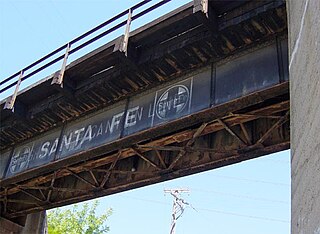
A plate girder bridge is a bridge supported by two or more plate girders.

A box girder bridge, or box section bridge, is a bridge in which the main beams comprise girders in the shape of a hollow box. The box girder normally comprises prestressed concrete, structural steel, or a composite of steel and reinforced concrete. The box is typically rectangular or trapezoidal in cross-section. Box girder bridges are commonly used for highway flyovers and for modern elevated structures of light rail transport. Although the box girder bridge is normally a form of beam bridge, box girders may also be used on cable-stayed and other bridges.
The National Bridge Inventory (NBI) is a database, compiled by the Federal Highway Administration, with information on all bridges and tunnels in the United States that have roads passing above or below them. That is similar to the grade-crossing identifier number database, compiled by the Federal Railroad Administration, which identifies all railroad crossings. The bridge information includes the design of the bridge and the dimensions of the usable portion. The data is often used to analyze bridges and to judge their condition. The inventory is developed for the purpose of having a unified database for bridges to ensure the safety of the traveling public, as required by the Federal Aid Highway Act of 1968. It includes identification information, bridge types and specifications, operational conditions, bridge data including geometric data and functional description, and inspection data. Any bridge more than 20 ft long used for vehicular traffic is included.

A girder is a beam used in construction. It is the main horizontal support of a structure which supports smaller beams. Girders often have an I-beam cross section composed of two load-bearing flanges separated by a stabilizing web, but may also have a box shape, Z shape, or other forms. Girders are commonly used to build bridges.
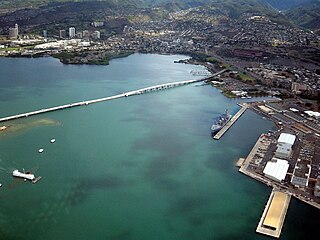
Admiral Clarey Bridge, also known as the Ford Island Bridge, is a 4,672 ft (1,424 m) road bridge that connects Ford Island in Pearl Harbor to the mainland of Oahu, the third-largest island of Hawaii. A 930 ft (280 m) section of it is supported by pontoons, and can be moved to allow vessels to pass through. This floating moveable span is the largest in the world.
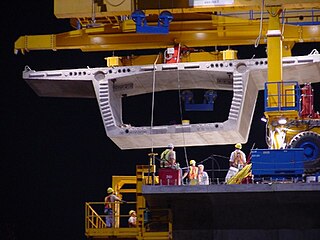
A segmental bridge is a bridge built in short sections, i.e., one piece at a time, as opposed to traditional methods that build a bridge in very large sections. The bridge is made of concrete that is either cast-in-place or precast concrete.

The Seal Island Bridge is a bridge located in Victoria County, Nova Scotia. It is the third longest bridge span in the province.
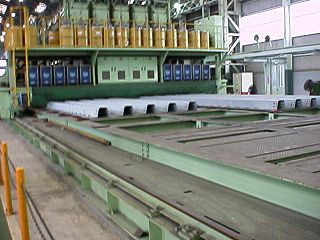
An orthotropic bridge or orthotropic deck is typically one whose fabricated deck consists of a structural steel deck plate stiffened either longitudinally with ribs or transversely, or in both directions. This allows the fabricated deck both to directly bear vehicular loads and to contribute to the bridge structure's overall load-bearing behaviour. The orthotropic deck may be integral with or supported on a grid of deck framing members, such as transverse floor beams and longitudinal girders. All these various choices for the stiffening elements, e.g., ribs, floor beams and main girders, can be interchanged, resulting in a great variety of orthotropic panels.
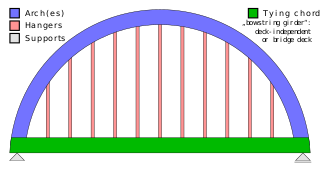
A tied-arch bridge is an arch bridge in which the outward-directed horizontal forces of the arch(es) are borne as tension by a chord tying the arch ends rather than by the ground or the bridge foundations. This strengthened chord may be the deck structure itself or consist of separate, independent tie-rods.

Precast concrete is a construction product produced by casting concrete in a reusable mold or "form" which is then cured in a controlled environment, transported to the construction site and maneuvered into place; examples include precast beams, and wall panels for tilt up construction. In contrast, cast-in-place concrete is poured into site-specific forms and cured on site.

The original Walnut Lane Memorial Bridge was a prestressed concrete girder bridge in Philadelphia, Pennsylvania, designed by Belgian Engineer Gustave Magnel and built by the City of Philadelphia. Completed and fully opened to traffic in 1951, this three-span bridge carried Walnut Lane over Lincoln Drive and Monoshone Creek. It was the first major prestressed concrete beam bridge designed and built in the United States when completed.

A deep foundation is a type of foundation that transfers building loads to the earth farther down from the surface than a shallow foundation does to a subsurface layer or a range of depths. A pile or piling is a vertical structural element of a deep foundation, driven or drilled deep into the ground at the building site.

A T-beam, used in construction, is a load-bearing structure of reinforced concrete, wood or metal, with a T-shaped cross section. The top of the T-shaped cross section serves as a flange or compression member in resisting compressive stresses. The web of the beam below the compression flange serves to resist shear stress. When used for highway bridges the beam incorporates reinforcing bars in the bottom of the beam to resist the tensile stresses which occur during bending.

A double tee or double-T beam is a load-bearing structure that resembles two T-beams connected to each other side by side. The strong bond of the flange and the two webs creates a structure that is capable of withstanding high loads while having a long span. The typical sizes of double tees are up to 15 feet (4.6 m) for flange width, up to 5 feet (1.5 m) for web depth, and up to 80 feet (24 m) or more for span length. Double tees are pre-manufactured from prestressed concrete which allows construction time to be shortened.

A launching gantry is a special-purpose mobile gantry crane used in bridge construction, specifically segmental bridges that use precast box girder bridge segments or precast girders in highway and high-speed rail bridge construction projects. The launching gantry is used to lift and support bridge segments or girders as they are placed while being supported by the bridge piers instead of the ground.
The Harbor Bridge Project is the replacement of the existing through arch bridge that crosses the Corpus Christi Ship Channel, which serves the Port of Corpus Christi in Corpus Christi, Texas, with a modern cable-stayed bridge design. The route will connect with SH 286 at its southern terminus and US 181 on the north. Groundbreaking on construction took place on August 8, 2016 and was scheduled to be completed by the spring of 2020, but was extensively delayed due to engineering and design issues, and is tentatively planned to be completed in 2025.

The Florida International University pedestrian bridge collapse occurred on March 15, 2018, when a 175-foot-long section of the FIU-Sweetwater UniversityCity Pedestrian Bridge collapsed while under construction. The collapse resulted in six deaths, ten injuries, and eight vehicles being crushed underneath. Of the serious injuries, one employee was permanently disabled. At the time of the collapse, six lanes of road beneath the bridge were open to traffic.




















